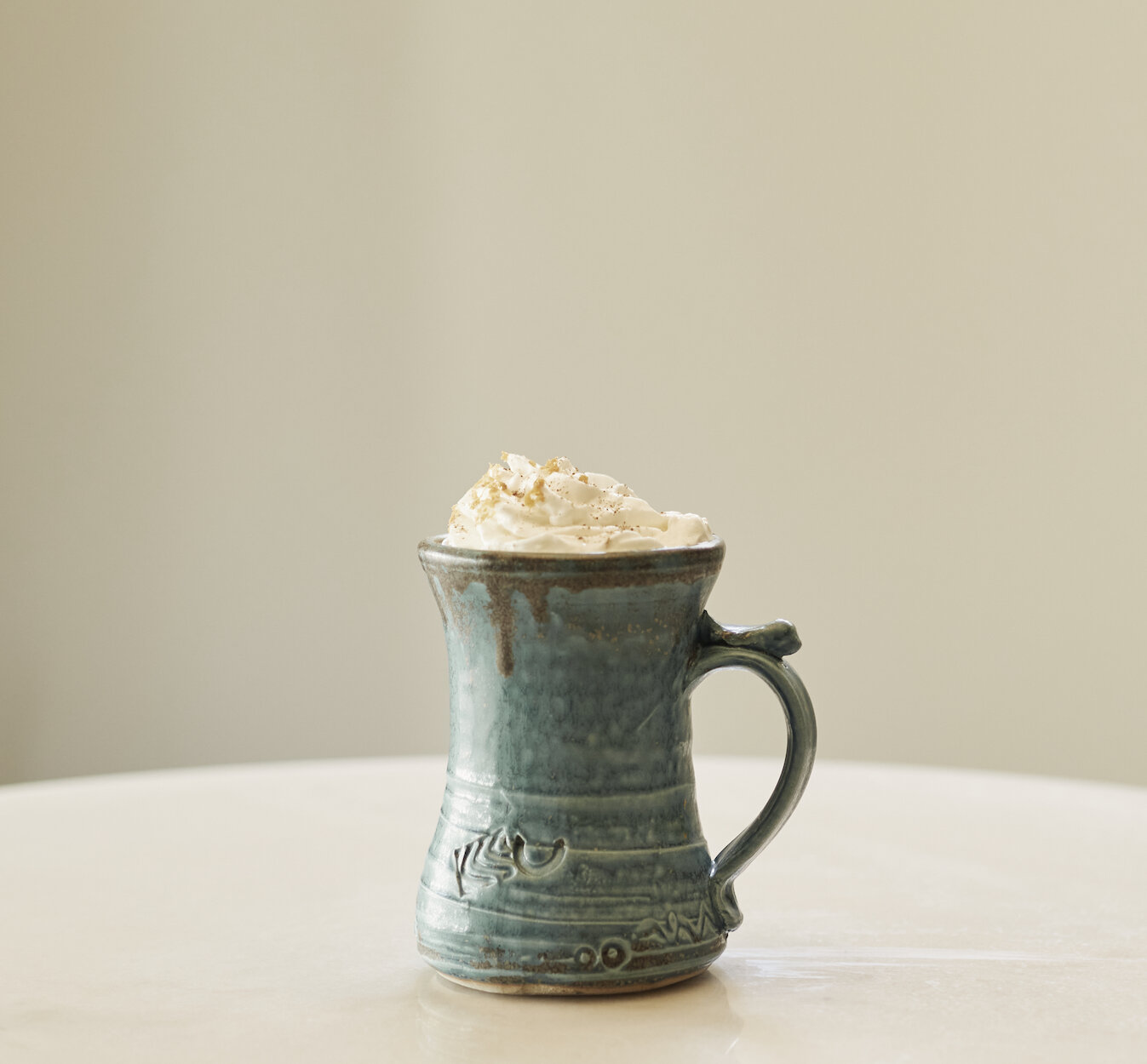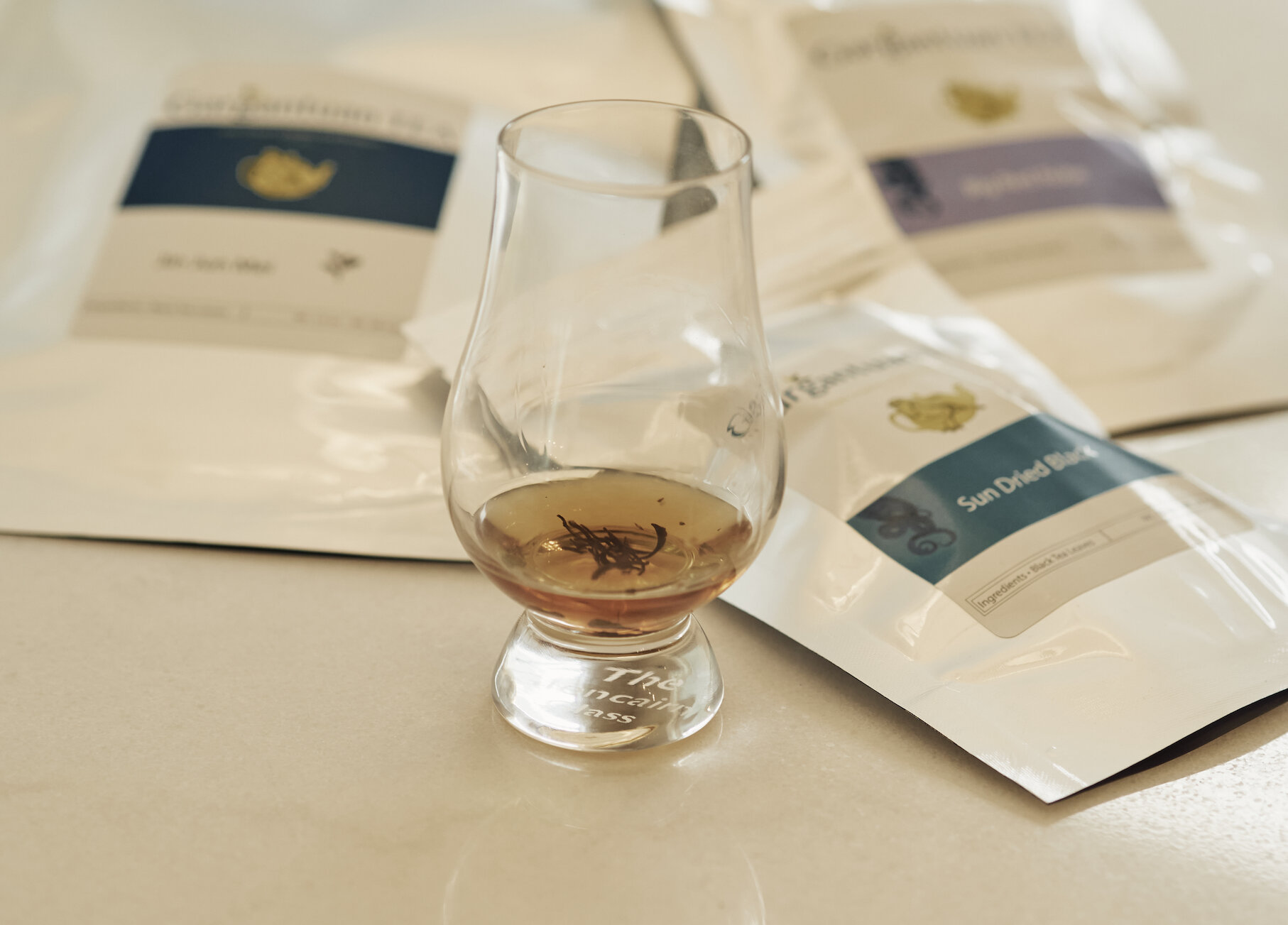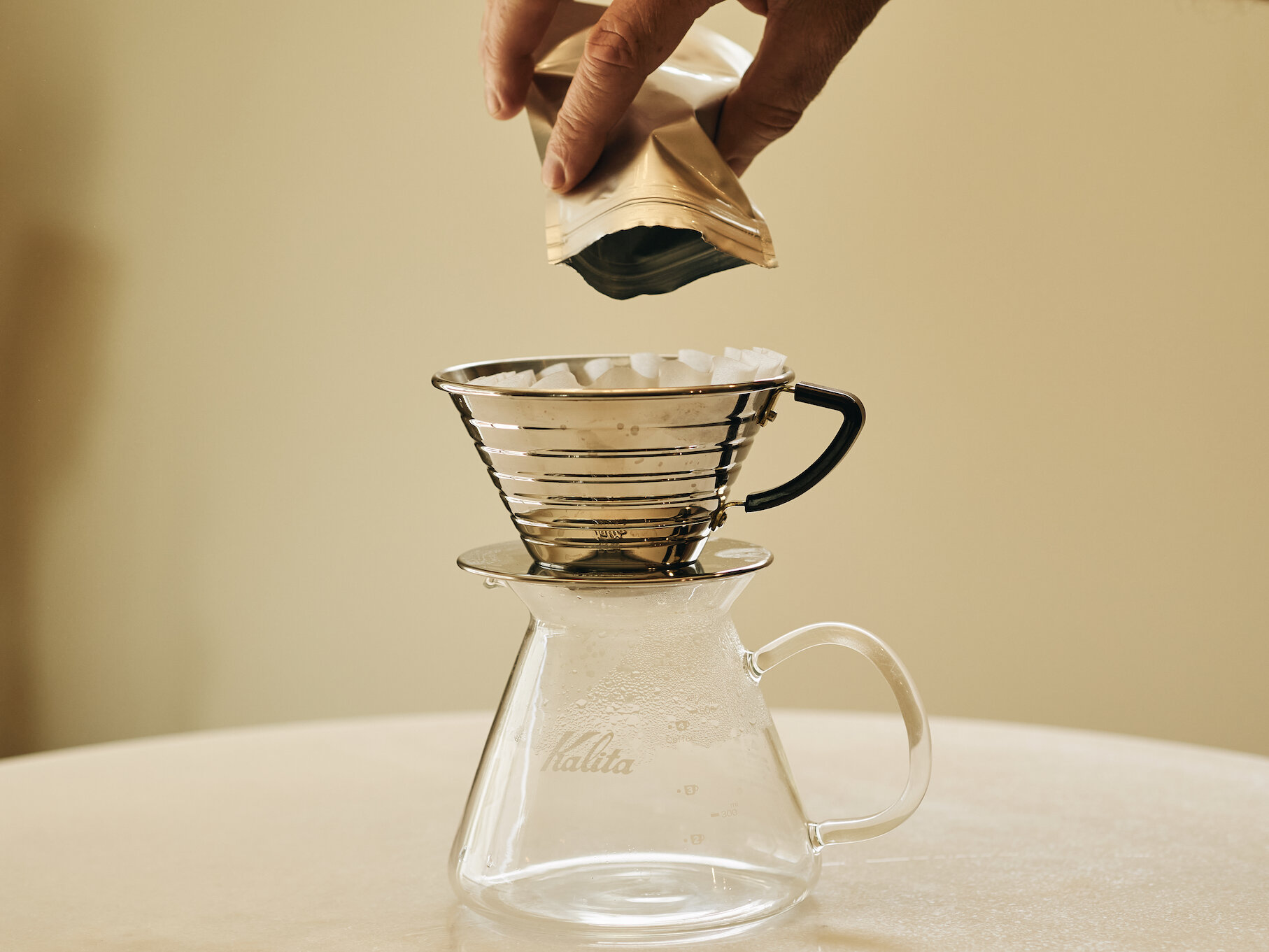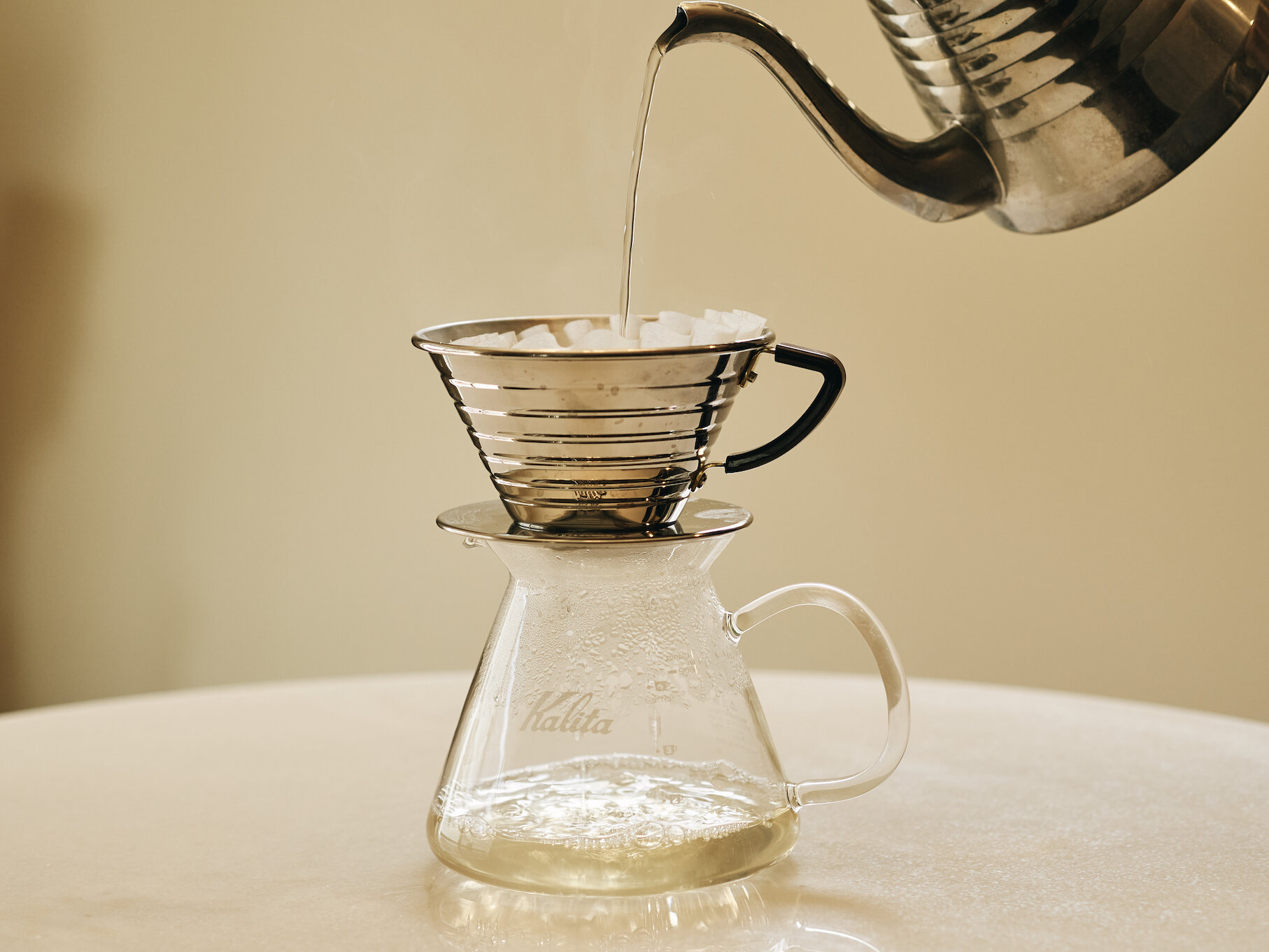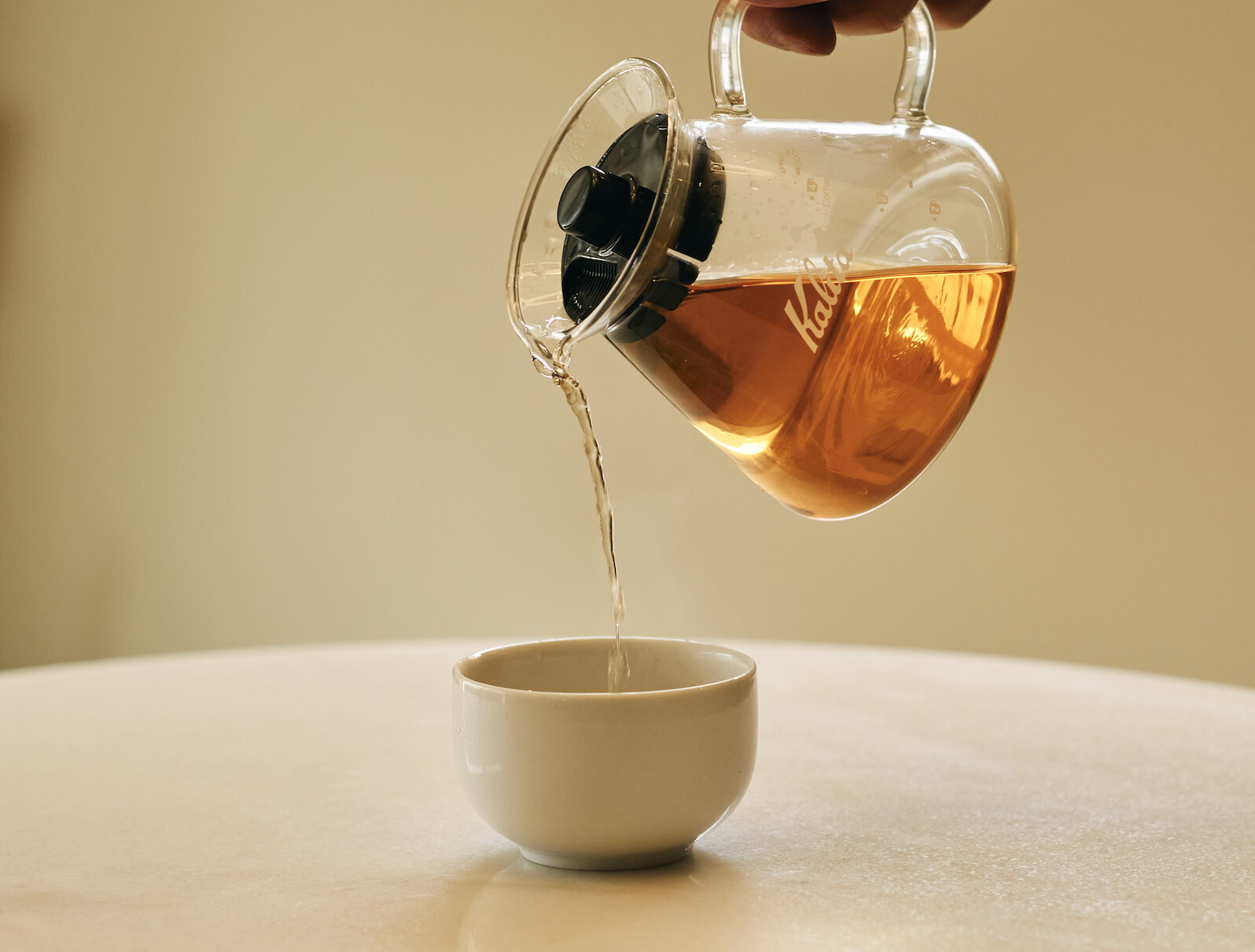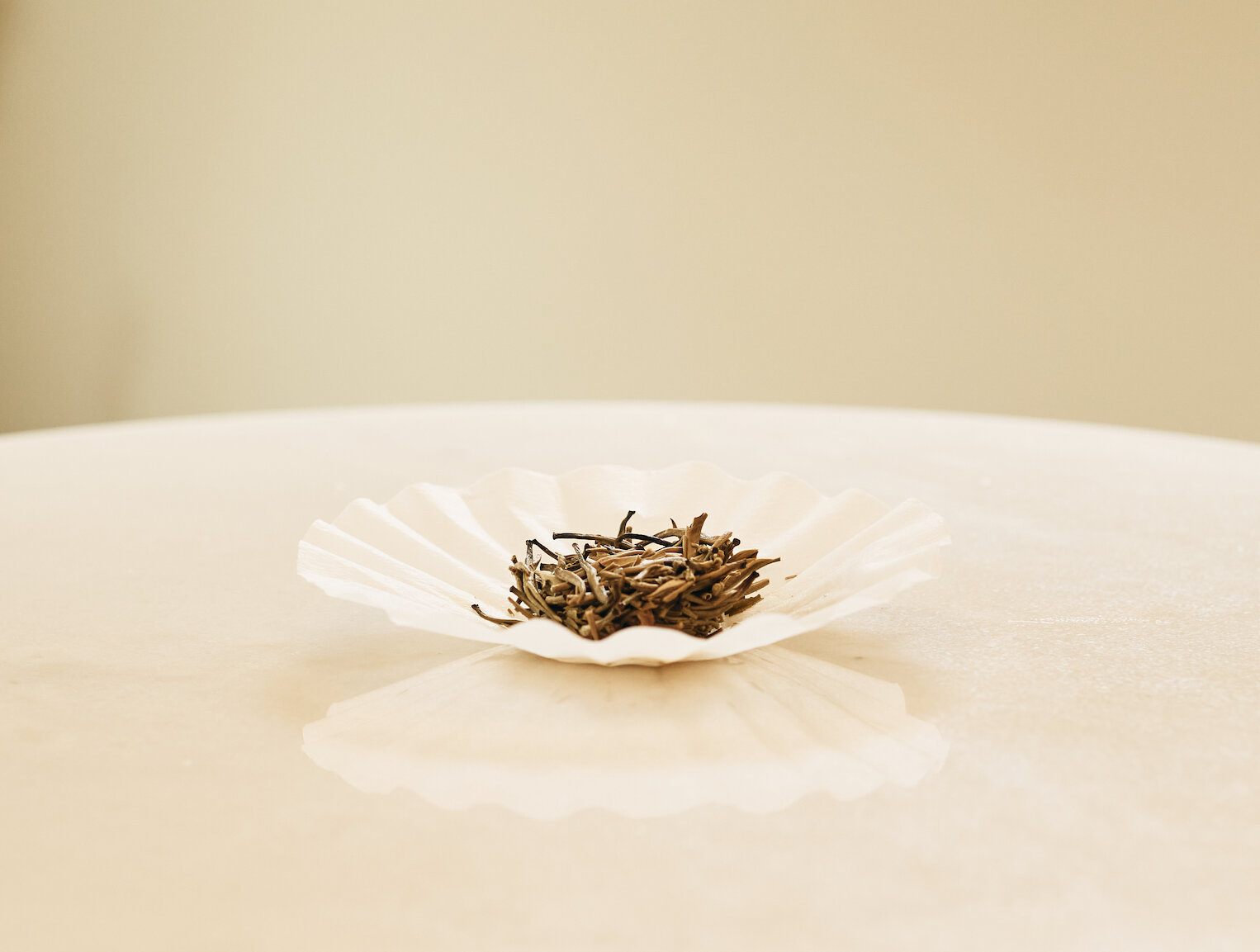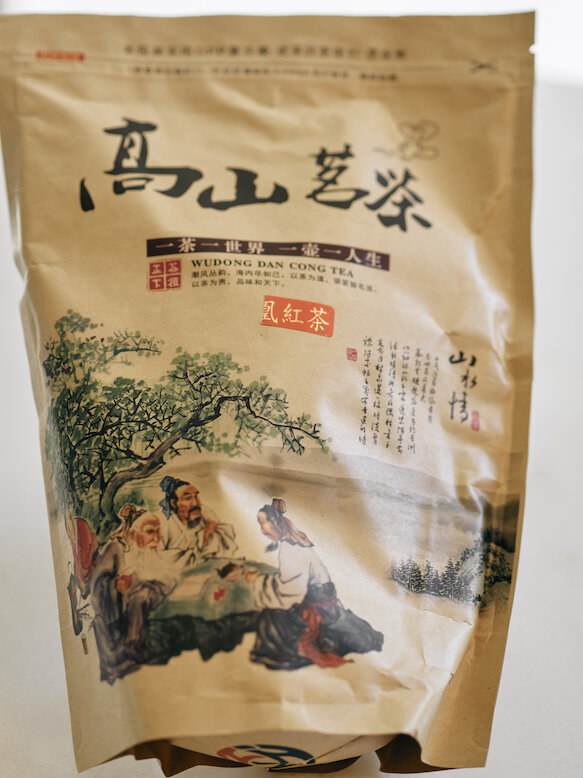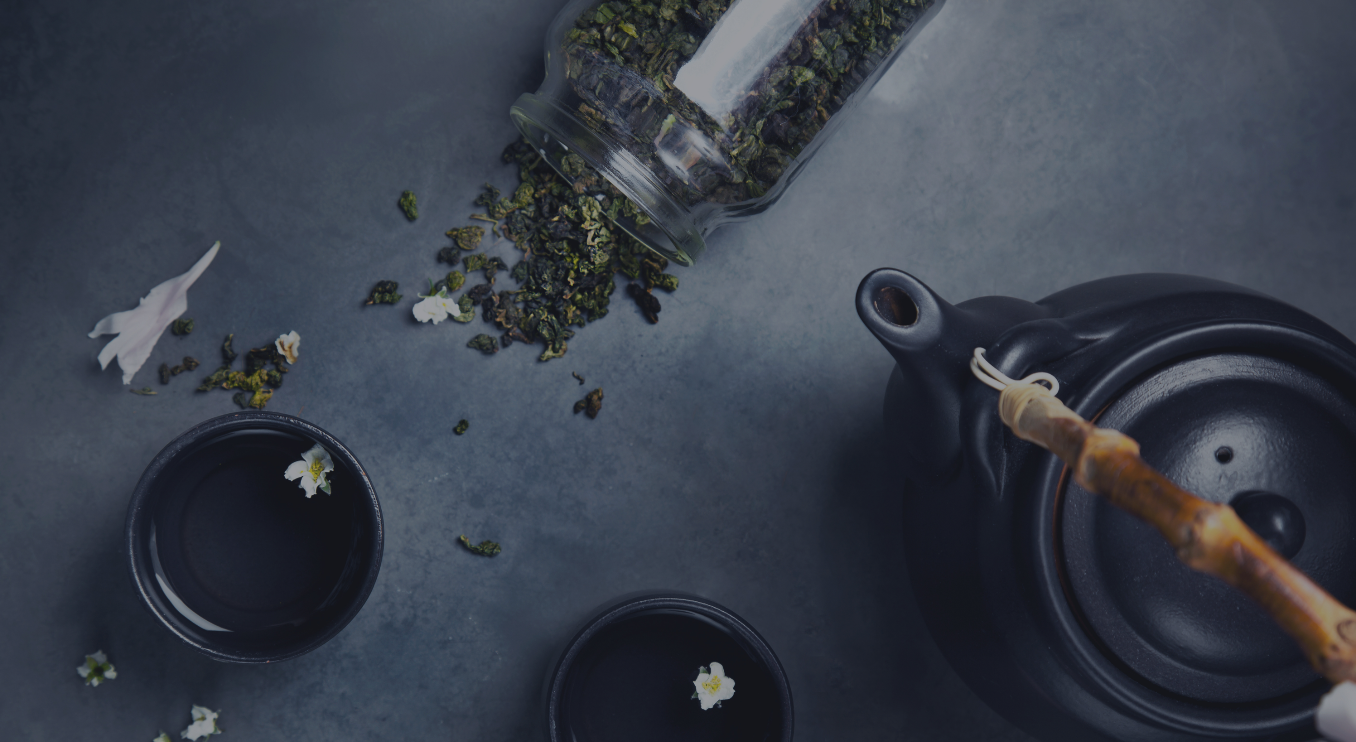
Make a Substantial Discovery
Seasonal Recipe: Leaf Turn Latte with Jin Jun Mei
Once steeped you are ready to pour the brewed tea latte into your 12 oz glass or mug. After pouring, stir the spice ingredients thoroughly. You may top with whipped cream. We suggest it! And garnish with a sprinkle of nutmeg and orange zest for an enticing accent of color in keeping with the seasonal theme. The essential oils in orange zest help to lift the tea and spice aromas, as well as to overlay another flavor element.
Jin Jun Mei is the perfect accompaniment to a seasonal drink …In this case, our Leaf Turn Latte
There are devotees who would never dream of corrupting the pure flavors offered by any high quality beverage, be they found in tea or wine or spirits, or really any drink of merit. The thought is often something along the lines of, “Drink the good stuff straight and save the cheaper fare for messing around.” But any good turn of phrase deserves a thought provoking counterpoint, and the adage, “If you wouldn’t drink it, definitely don’t cook with it,” delivers us pause for reconsideration. While a purist at heart, it is nevertheless clear to me that options for new ways to enjoy old favorites benefit everyone.
Although not new by any measure, tea is undergoing a resurgence and experiencing rapid growth in the US. Boba tea is a phenomenon unto itself. Almost every mall has at least one store front. Thankfully high quality tea is also gaining a following, in many ways mirroring the cafe scene explosion that happened decades earlier. In fact, we can learn a lot from cafes…from the discerning eye firmly affixed upon quality, to the development of technique able to encapsulate both artistry and reproducibility, all the way through the creation of their own resonating culture.
Preparing the pot for steeping with a hot hater rinse
It’s fall and I wanted to create a spiced seasonal drink that would serve a slightly different riff on an old favorite, while still highlighting the main tea ingredient rather than overwhelming it. We are primarily after balance, and the goal of having all elements work together to compliment one another. Jin Jun Mei is a great choice for this. The famed tea of Tongmu in Wuyishan, China already delivers a hearty cup. Boasting flavors of malt, milk chocolate, and rye bread, it is exactly what you want to warm the whole of your constitution as the seasons change and the weather becomes a little more brisk. Jin Jun Mei is harvested from tiny, golden spring buds, a very labor intensive process for the experts involved in hand picking. The downey buds contain more sugar and carbohydrate, which lend themselves to notes of malt, as well as to a generous and satisfying palate presence.
Seasonal spices eagerly await the warm embrace of a brewed tea latte
Jin Jun Mei also has a hint of nutmeg on its own, so the inherent flavor profile is perfectly suited for the complimentary addition of traditional fall spices.
Add the following ingredients to a serving glass:
1/4 teaspoon of cinnamon
1/8 teaspoon of allspice
A few drops of vanilla extract
(option: to include a small amount of fresh minced ginger, not too much)
The golden hue of our brewed tea latte as it is poured into a fitting mug
In preparation, we must first warm the tea pot using boiling water. Filling to 70% full is ideal. After 20 seconds discard the water. This is important because we must retain the high temperature of the brewing liquid so we don’t experience a temperature drop that will negatively impact our extraction during brewing.
Add 7.1 g (1/4 oz) of Jin Jun Mei black tea to the pot. We are using a higher rate of tea because we are brewing with milk; crucial, in order for the flavors to come through as desired.
Add 3 oz of boiling water. Let steep for 45 seconds. Next, add 9 oz of whole milk on top of the water that has been pre-heated and pulled, just as it is beginning to show signs of nearing a boil. Whole milk can be heated first on the stove or in a microwave. Just be sure to keep a close eye on it. Once the heated milk is added you will steep for an additional 3 to 4 minutes.
Again, the steep time is likewise increased so that the flavors fully saturate within the milk used for brewing. Milk has many components that absorb flavor, effectively muting their expression. Additionally, the protein content of milk is one such attribute that will also alter the textural elements imparted by tea. All this really means is you have to use more tea and to steep the tea longer in order to achieve the desire effect you are after. In this case, a flavorful tea latte!
Leaf Turn Latte finished and garnished in a mug
Once steeped you are ready to pour the brewed tea latte into your 12 oz glass or mug. After pouring, stir the spice ingredients thoroughly. You may top with whipped cream. We suggest it! And garnish with a sprinkle of nutmeg and orange zest for an enticing accent of color in keeping with the seasonal theme. The essential oils in orange zest help to lift the tea and spice aromas, as well as to overlay another element of flavor. You can get as creative as you like. Add a cinnamon stick for fun. There are quite a few opportunities for your own personal touch. …Why not candy some ginger if you have the time?
Or if you prefer, our Leaf Turn Latte finished and garnished in an “eternal” green glass!
There you have it! The Leaf Turn Latte featuring Jin Jun Mei. Not only is this drink satisfying, it is surprisingly refreshing. It out classes the ubiquitous, humdrum pumpkin spiced latte any day of the week. There is more complexity with brighter, more well-defined flavors bursting forth. It doesn’t beat you over the head. It invites you in! And there is something reassuring, almost eternal about the tiny spring buds of Jin Jun Mei still shining bright as ever in a delectable fall concoction that bolsters us as the days continue growing shorter.
Exalted Steps: Experimenting with Tea Blending in Michter’s Rye Whiskey
In food and beverage, occasionally a counterbalance is struck and contrasting tastes can make for a judicious occasion, while other times, it takes like components in order to play friendly together and gain complementary flavors. In this limited experiment the later seemed to decisively reign as the best route forward. Further, when in doubt, the mitigating factor of a judicious eye-dropper of vanilla extract was used to smooth over any prickly faults. This helped to lessen the perception of negatives, so positive effects would be more readily apparent.
Loose leaf tea has an enormous potential as an ingredient in various food, beverages and desserts. In this instance we look toward black and oolong tea to favorably impact a mid-tier rye whiskey. We used several teas in the Gargantuan line for this experiment with Michter’s Rye as the blending spirit. Yunnan Sun Dried black, Jin Jun Mei, and Big Red Robe oolong, along with the late entry of Yunnan Golden Fleece sum up the roster for our experiment.
and we are off to the races… the glass is poured and our tea leaves steeping; there are endless more choices to be had
Generally, it is a notoriously difficult proposition to successfully blend similar beverages, let alone to combine different beverage types, especially when involving high proof spirits. The risk with this type of blending is having the resultant concoction to become disjointed rather than possessing a level of additive cohesion. Tea has tannin and spirits have, well, alcohol. The stage is then set for an epic challenge to attempt to thread the needle and to avoid additional astringency, bitterness and heat.
We tried a few techniques; firstly just throwing dried tea leaves in a dram of whiskey. But because of the minimal moisture content of dried tea, and due the high alcohol environment, not surprisingly, our tea proved resistant to hydration and extraction. In response we did a hot water rinse to open up the leaves. Next we tried brewing the tea and titrating in a meager amount of the golden liquor into the true, and intoxicating liquor. Finally, the last method was a role reversal; to spice in some rye whiskey into a full-bodied cup of freshly steeped tea.
a dram with Jin Jun Mei and some of the other tea ‘players’
In food and beverage, occasionally a counterbalance is struck and contrasting tastes can make for a judicious occasion, while other times it takes like components in order to play friendly and attain complementary flavors. In this limited experiment the later seemed to decisively reign as the best route forward. Further, when in doubt, the mitigating factor of a judicious eye-dropper of vanilla extract was used to smooth over any prickly faults. This helped to lessen the perception of negatives, so positive elements were more readily apparent.
We found in the most favorable instances we were able to achieve an increase in aromatics, mid-palate, as well as in the length of the finish. Of course, these clear wins were often complicated by a disruption to the full cohesion of flavors.
dry tea leaves struggling to unwind
Hydrated leaves of Jin Jun Mei worked well. They have elements of rye themselves, and a spice component that is similar to nutmeg. Not surprisingly they added a bump to spice complexity, as well as to mid-palate. Our final foray involving Golden Fleece was a similar success. Golden fleece also has a complex, spice-box nose that includes ginger among other interesting aromas. Again, these attributes played well with our chosen spirit, Michter’s rye whiskey.
whiskey in tea, straight… tea in whiskey, add some vanilla
On the back end, blending a 5% whiskey addition to brewed Golden Fleece tea seemed advantageous. It gave it an interesting edge, and it upped the perception of spice characteristics, while yielding an enhanced and lively palate presence.
Somewhat surprisingly, we did not find as much obvious success with our Sun Dried black tea, or even with our Big Red Robe oolong, the latter, serving up floral aromas that otherwise might have balanced the herbal rye characters.
we end where we started, a couple of concoctions before us… some have been nice, some have been not so nice!
In the future it would certainly be worthwhile to include a range of spirits, and to get more creative with tea preparations. Hopefully, this little exercise will inspire you to play around with the possibilities of tea in food or beverage recipes of your own. You don’t have to limit your fun to spirits, but it is also not a bad place to start. You might stumble onto something truly delicious… But more importantly, you will definitely learn, as well as develop a greater appreciation for tea and those elements which can pair well together.
Developing a Pour Over Technique for Tea Brewing Using the Kalita Wave
It is possible that by developing a pour over technique for tea we could open up the pleasures of tea drinking to even more than currently benefit from its enjoyment, while likewise, increasing the accessibility of tea for its seasoned drinkers as well.
After the filter rinse. Ready for loose leaf tea and pour over brewing
Why did we try an altogether different method for brewing tea? It’s good to keep an open mind and to try new alternatives because you might find value you didn’t initially expect. Though brewing tea is several millennia-old, times change and there are new motivations to consider for honing your tea craft. We looked into pour over brewing because of the simplicity and due to its rampant success within the coffee realm. Anecdotally, we also heard from many casual tea drinkers that they themselves have experimented with pour over tea brewing. Because it is both a common kitchen accessory and perceived as a straight forward, timesaving process too. It stands to reason that by comparison standard tea brewing can at times be viewed as nebulous; perhaps harder to perfect, and certainly taking more time to complete.
Adding the appropriate amount of loose leaf tea
Therefore, it is possible that by developing a pour over technique for tea we could open up the pleasures of tea drinking to even more than currently benefit from its enjoyment, while likewise, increasing the accessibility of tea for its seasoned drinkers as well. And on the consumer-retail side, coffee shops and the like, might be more apt to incorporate higher quality tea within their offerings if we as purveyors of fine tea speak a language they can more easily understand. Of course utilizing equipment they already possess and know how to use is one of the best ways to do this.
In our experiments we utilized a Kalita Wave 185 stainless steel dripper, paired with their corresponding filter paper and glass coffee server. It was important to choose a relatively inert dripper. We did not want to consider plastic or copper, materials which would negatively impact tea taste. Ceramic is a solid alternative, but because of its substantial mass it would in fact necessitate the extra step of heating the dripper prior to brewing. Because our goal was to streamline, we chose the stainless steel version as the best option.
Brewing a white tea by pour over
Preliminary brews showed that the flow rate is such that you can consistently brew 12 ounces of tea in about 90 seconds if continually poured. We found this to work especially well with black tea. Upon further brews evaluating a diverse range of tea, we found the pour over value robust enough to apply successfully to many types of white, green, oolong and pu-erh teas. Modifications were made to our standard pour over process to account for tea type considerations. These considerations are two-fold, and always involve responding to specific attributes of the tea leaves themselves.
One, is the tea rinse for oolong or pu-erh that require a brief hot water rinse to open up the leaves prior to brewing. Rinsing simply involves submerging the leaves in hot water for a short time and then discarding the resultant brew. Two, is avoiding leaf damage from scalding due to prolonged exposure of high temperature brewing water. White tea and particularly green tea, which often requires the lowest brewing temperatures, are more susceptible. There are a couple ways this can be achieved. The temperature of the brewing water can be cooled by exercising a waiting period after boiling and just prior to brewing. However, additional time is counter to our goal for a streamlined process. An effective method for use in combination is to pour water from a high level to benefit from air cooling, and further, to let the leaves “rest” periodically by allowing the water to drain down completely in regular intervals while brewing. As the water drains down the leaves will naturally cool.
Brewed white tea ready to be poured from the server
The great thing about using our pour over technique in tea brewing is there is an elegant simplicity about the process that has inherent utility. Let’s highlight a couple features previously mentioned and touch on some new ones: 1) The use of a stainless dripper foregoes the need for a pot heating step. 2) The pour over brewing process achieves consistent results and prevents over-steeping; avoiding extracted, bitter and unbalanced brews. 3) Because hot water is replenished as brewed tea exits the pour over, there is a constant gradient for enhanced brewing. 4) Rinsing, brewing and cooling are each controlled when necessary by the simple method of timing and by positioning your pour. 5) Similarly, the pour over brewing action “self regulates” rinsing, brewing, and cooling requirements.
Serving pour over brewed white tea
The biggest take away when comparing pour over brews with other methods is that it is easier to achieve balance of flavor brew to brew. This consistency is an added benefit above the attractiveness of the quick results, or even the easy steps employed to get you there. When using pour over for tea you are likely to find bright, vibrant flavors, a silky texture, and the true complexity you would hope each fine tea to generously offer.
Simple pour over instructions when serving customers in retail settings.
Full pour over instructions with options for the tea enthusiast’s consideration.
Serving pour over brewed black tea
spent white jasmine leaves after brewing
A Decadent Riff on Breakfast Tea - Mi Lan Black Tea (Dancong)
So I ask you, make space and consider another tea, and the very idea of it, when you have your morning cuppa. Mi Lan Black could be the next breakfast tea. And it all starts tomorrow with your next cup.
Mi Lan Dancong black tea, served in a Wedgewood cup
Breakfast tea is often what we drink when we drink tea for the first time. It is not only likely our first experience with tea, but unless we are avid tea enthusiasts it is also more likely what we continue to drink on a daily basis.
Breakfast tea is a loose term. There are no earnest specifications that must be met in order to carry the moniker of breakfast tea. Instead, it must simply serve a purpose. Breakfast tea need only be a robust brewed cup of tea to simultaneously play both foil and accompaniment to a hearty breakfast. It must stand up to a savory, laden affair as well as it can with the confectionary bent, served in baked goods. …Oh, and it is usually black; though it wasn’t always necessarily, and though it doesn’t really have to be. But actually, breakfast tea is simply breakfast tea because you call it that.
In early-18th century England two events occurred which set the stage for the creation of breakfast tea. Tea prices dropped and Queen Anne started taking tea in the morning instead of ale. The accessibility of tea along with the predictable trend of the British following suit with known habits of their sovereign, had the immediate effect to extoll breakfast tea as an enthusiastic fashion for the realm.
English breakfast tea, like any good origin story, isn’t entirely clear. The notion of the naming itself hints at the likelihood of an external origination. One possibility is that British immigrant and tea merchant Richard Davies invented it in New York in 1843. Supposedly by combining an appealing blend of Chinese tea, (Congou, Pekoe, and Pouchong) in doing so, English breakfast tea was born.
Apparently priced right and rather good, the concoction met with early success and just as quickly, spawned imitators. An 1876 edition of the Daily Alta California seems to support the notion, as it cites an earlier “New York commercial journal,” dating the birth of English Breakfast to 1844. Similarly, an American publication in 1884 made a testament that Bohea (Wuyi) teas were known to trade as English Breakfast, and were, “forming the staple shipment to England.”
On the other side of the pond, the view is a little different. Scots tea merchant Robert Drysdale is purported to have developed the blend dubbed “Breakfast Tea” in 1892, when he judiciously incorporated leaves of Ceylon, Keenum and Assam teas together. While at the royal residence, Balmoral, in Scotland, Queen Victoria is said to have tasted the result in 1892. Her fondness for the tea blend inspired her to return to England with a large sum of it in tow. Eventually the adoption by her majesty earned the tea the “English” attribution, and Drysdale’s “Breakfast Tea” was, from then on, forever known as “English Breakfast Tea.”
Oolong and black teas have almost exclusively comprised breakfast tea in addition to its predecessor. During the days of high prices and heavy taxation in England, there was a growing black market in response that included a litany of ridiculous adulterations, collectively known as “smouch.” Passing off bogus green tea was a far easier task it seems, so black and oolong tea became more popular as an inherently authentic product.
As alluded earlier, it wasn’t uncommon for breakfast teas to be sourced from Wuyishan; be they oolong or black. Wuyi Rock Tea was well known and well regarded, and counts among its storied ranks, Lapsang Souchong, which is itself the world’s first black tea, as well as being the origin of Earl Grey. …An entirely fascinating, criss-crossing story for another time.
Consider a different region now, this time in Guangdong Province, nestled among the rocky peaks of the fabled Phoenix Mountains. Oolong cultivars for tea aficionados are the equivalent of the Syrah grape for wine lovers. Their mutual fondness for rocky terroir and harsh environs brings out diverse but always dazzling expressions that delight, and overtime, become the basis of lore.
Mi Lan Xiang tea is produced from a varietal commonly used in production for some Phoenix oolongs. It is appreciated for the honey orchid flavors for which it is named. Because of the bold, sweet aromas it is accessible and tends to be considered an introductory Phoenix oolong. My description is not meant to do a disservice, but simply to highlight the tea’s broad appeal. Another consideration is that the better permutations of this tea are Dancong. Dancong translates as, “independent bush.” They grow as wild plants. The deep root structure in part distinguishes them from cultivated plants often propagated from cuttings and without a taproot system. So too, the age of the tree and the elevation are crucial to quality. The older, more mature trees and the examples at higher elevation generally being greatly esteemed… Some trees are well over 500 years old, and on Wu Dong peak, attain a growing altitude of 1,300 meters or more.
This particular 2020 Mi Lan (Xiang) Black tea was produced by Huang Rui Guang, a tea producer, accomplished author, and considered locally as a cultural treasure. Through his effort, Master Rui Guang has crafted a black tea from this traditional Phoenix oolong variety by allowing it to oxidize naturally over 24 hours before being carefully spread, baked and tumbled. I liken the entirety of it to a deep sea convergence zone. Placid expectations are attained, day in, day out; devoid of further consideration. Until unexpectedly from nowhere, the water surface ripples, rock miraculously wells…finally breaching into daylight with spectacular creation. The result is instantly appreciated because much of the sweet, floral aromatics are retained amidst the altogether new canvas of a robust, nuanced black tea. In fact, an earlier version earned a gold medal in 2015 at the Sixth Guangdong Tea Expo. While the elevation for the sourcing of this tea is moderate at 600 meters, and the age of the trees are scarcely known, we can be sure the favorable pricing offers considerable value for the unique, well-made offering.
I am not partial to a sweet, overly indulgent morning routine. Actually, it is no rarity for me to dispense with breakfast altogether. But I never disregard morning tea. Mi Lan Black is a meal in itself. It is like drinking breakfast, although much more palatable than a protein shake. Funnily enough, and more realistically maybe, it could well be a pancake breakfast! If I can be forgiven for being so vain as to highlight my own tasting notes at this point: “Honey elements hum; though less on the floral side. The expression shows buttery, brown sugar notes to go along with the fry bread aromas. Think buckwheat pancakes for breakfast! Apricot and plum are elevated by star anise and cinnamon. A tingling texture and viscous palate weight are fondly regarded. The leaves pleasantly fill the air with apricot, spice and brown sugar.” At the day’s end this tea is an “all day” tea, just as those preferred tea to be since the inception of the breakfast tea concept. It can be drunk on its own or with anything you might be inspired to partake as a morning meal.
Maybe eventually someone can christen this worthy potion “PNW Breakfast Tea,” or wherever it happens to dig in its deepest roots of popularity. If such is the case, I will realize as I do now that I didn’t do a thing. There was no process, no trial and error, no resultant blend, or the aha moment that comes with it! But the bones of the matter are I am choosing this tea. And choosing is good enough.
So I ask you, make space and consider another tea, and the very idea of it, when you have your morning cuppa. Mi Lan Black could be the next breakfast tea. And it all starts tomorrow with your next cup.







